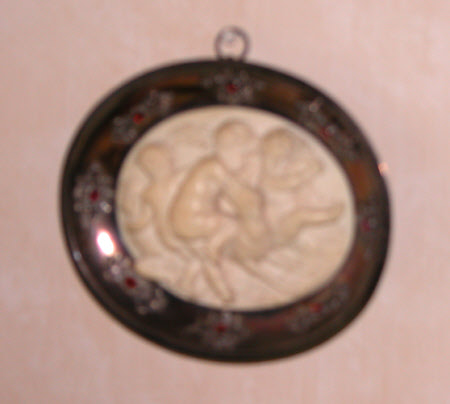Four small boys fighting and playing with a dog
Category
Art / Sculpture
Date
c. 1700 - 1730 (or c. 1850-1900)
Materials
Ivory in silver mount set with garnets
Measurements
98 x 122 mm
Order this imageCollection
Anglesey Abbey, Cambridgeshire
NT 516608
Summary
Sculpture, ivory; boys playing with a dog; Flemish or German; c. 1680-1730, or c. 1850-1900. An oval ivory relief depicting small boys (putti) fighting and playing with a dog. The design reflects the work of François Duquesnoy (1597-1643), who popularised small sculptures and reliefs of putti, and was probably made in the Southern Netherlands (Flanders) or Germany. Two other versions of the relief are known, one signed by the German painter and ivory sculptor Paul Heermann, who worked in Bohemia and in Saxony in eastern Germany. The Anglesey Abbey relief is closer to an unsigned version in the Bayerisches Nationalmuseum in Munich, copies of which were made in the nineteenth century.
Full description
An oval ivory relief depicting putti playing with a dog. In the foreground, a naked child tries to clamber onto the back of a dog, that bares its teeth at the child and barks in protest. At right another putto dances, holding a piece of drapery in his left hand whilst, at the left, two more boys are fighting, one with a leafy branch in his raised right hand. A rocky background. In a silver frame with applied decorative elements set with stones. The relief is a replica of a relief known in at least two other versions, one of roughly the same size (10.5 x 13.8 cm.) in the Bayerisches Nationalmuseum, Munich (Inv. R4692; Berliner 1926, no. 159, Taf. 87). The Munich relief is part of a series of four similar oval reliefs (Berliner 1926, nos. 157-60), the others depicting putti dancing, a young Bacchus with six children and putti playing with a monkey and a dog. The four reliefs were first recorded in a 1730 inventory of the collections of the Elector Palatine in Düsseldorf. They were regarded by Rudolf Berliner as derivative works, by an anonymous follower of François Duquesnoy (1597-1643), who popularised small sculptures and reliefs of putti, or of another sculptor, Lucas Faydherbe (1617-97). The second example, in the Herzog Anton Ulrich-Museum in Braunschweig (Inv. 277; Scherer 1931, no. 325), is signed ‚PH‘ in monogram form, for the ivory carver Paul Heermann (1673-1732), who worked mainly in Prague and his native Dresden, and is presumably based on the same unidentified model. The Braunschweig relief differs in a number of details from the reliefs in Munich and at Anglesey Abbey, for example in the depiction of the ground, suggesting that these were not made in Paul Heermann's workshop. The Anglesey Abbey relief on the other hand is very close to the version in Munich, which was copied in the nineteenth century (information from Dr. Jens Burk, Bayerisches Nationalmuseum, Munich). It is possible that the Anglesey Abbey relief therefore is a later copy of the Munich relief, but it may also be a contemporary version, made in the same unknown Flemish or German workshop in the late seventeenth or early eighteenth century. Yet another version, again very close to the Munich ivory, was exhibited by the Durch dealer Kollenburg at the TEFAF art fair in Maastricht in 2025. Jeremy Warren March 2025
Provenance
David Black; sold on 11 June 1956 to Urban Huttleston Rogers Broughton, 1st Lord Fairhaven (1896-1966), for £50; bequeathed in 1966.
References
Berliner 1926: Rudolf Berliner, Die Bildwerke des Bayerischen Nationalmuseums. IV. Die Bildwerke in Elfenbein, Knochen, Hirsch- und Steinbockhorn, Augsburg 1926, p. 47, no. 159, Taf. 87. Scherer 1931: Christian Scherer, Die Braunschweiger Elfenbeinsammlung: Katalog der Elfenbeinbildwerke des Herzog Anton Ulrich-Museums in Braunschweig, Leipzig 1931, p. 104, no. 325.
